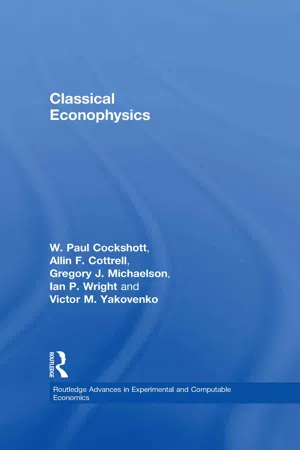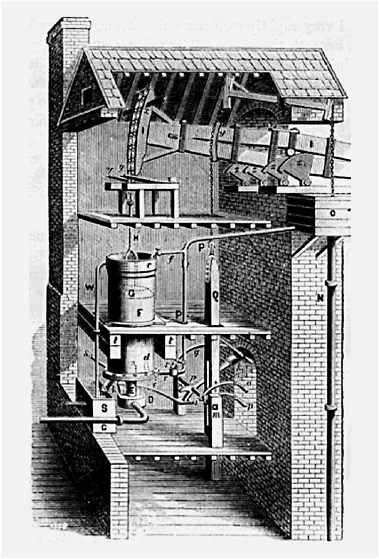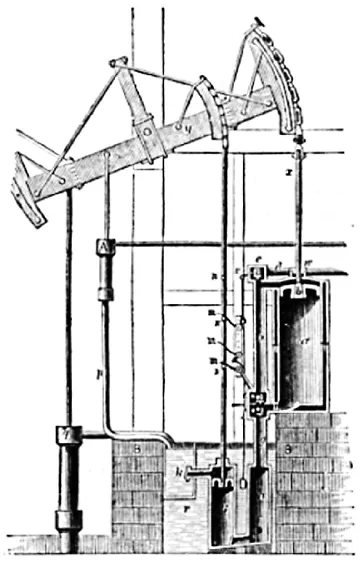1 Problematizing labour
1.1 Watt on work
Prior to the eighteenth century, muscles – whether of humans, horses or oxen – remained the fundamental energy source for production. Not coincidentally, the concepts of work, power, energy and labour did not exist in anything like their modern form. People were, of course, familiar with machinery prior to the modern age. The Archimedean machines and their derivatives – levers, inclined planes, screws, wheels, pulleys – had been around for millennia to amplify or concentrate muscular effort. Water-power had been in use since at least the first century A.D.,1 initially as a means of grinding grain; during the middle ages it was applied to a wide variety of industrial processes. But water-power, and its sister wind-power, were still special-purpose technologies, not universal energy sources. Limited by location and specialized use, they did not problematize effort as such.
A note on terminology is in order here. The (admittedly not very elegant) verb ‘to problematize’ derives from the work of the Althusser and Balibar (1970) who coined the term problématique (problematic) to refer to the field of problems or questions that define an area of scientific enquiry. The term is fairly closely related to Thomas Kuhn’s idea of a scientific ‘paradigm’ (Kuhn, 1970). So, to problematize a domain is to transform it into a scientific problem-area, to construct new concepts which permit the posing of precise scientific questions. In the pre-modern era engineers and sea captains would know from experience how many men or horses must be employed, using pulleys and windlasses, to raise a mast or obelisk. Millers knew that the grinding capacity of water mills varied with the available flow in the mill lade. But there was no systematic equation or measure to relate muscular work to water’s work, no scientific problematic of effort. That had to wait for James Watt, after whom we name our modern measure of the ability to work.
Watt, the best-known pioneer of steam, did not actually invent the steam engine, but he improved its efficiency. As Mathematical Instrument Maker to the University of Glasgow he was called in to repair a model steam engine used by the department of Natural Philosophy (we would now call it Physics). The machine was a small scale version of the Newcomen engine that was already in widespread use for pumping in mines.
Figure 1.1 The Newcomen engine built by Smeaton (reproduced from Thurston).
The Newcomen engine was an ‘atmospheric engine’. It had a single cylinder, the top half of which was open to the atmosphere (Figure 1.1). The lower half of the cylinder was connected via two valves to a boiler and a water reservoir. The piston was connected to a rocking beam, the other end of which supported the heavy plunger of a mine pump. The resting condition of the engine was with the piston pulled up by the counter-weight of the pump plunger.
To operate the machine, the boiler valve was opened first, filling the cylinder with steam. This valve was then closed and the water-reservoir valve opened, spraying cold water into the piston. This condensed the steam, resulting in a partial vacuum. Atmospheric pressure on the upper surface of the piston then drove it down, providing the power-stroke. The two-phase cycle could then be repeated to obtain regular pumping.
Watt observed that the model engine could only carry out a few strokes before the boiler ran out of steam and it had to rest to ‘catch its breath’. He ascertained that this was caused by the incoming steam immediately condensing on the walls of the cylinder, still cool from the previous water spray. His solution was to provide a separate condenser, permanently water-cooled, and intermittently connected to the cylinder by a valve mechanism. The cylinder, meanwhile, was provided with a steam-filled outer jacket to keep its inner lining above condensation temperature (Figure 1.2). His 1769 patent was for ‘A New Method of Lessening the Consumption of Steam and Fuel in Fire Engines’.
Figure 1.2 Watt’s steam engine with separate condenser (reproduced from Thurston).
Watt’s later business success was based directly on this gain in thermal efficiency. His engines were not sold outright to users, but were leased. The rental paid was equal to one-third the cost of coal saved through using a Watt engine rather than a Newcomen engine (Tann, 1981). This pricing system worked so long as the Newcomen engine provided a basis for comparison, but as Watt’s engines became the predominant type, and as they came to be used to power an ever-widening range of machines, some system of rating the working capacity of the engines was needed. Watt needed a standardized scale by which he could rate the power, and thus the rental cost, of different engines. His standardized measure was, of course, the horsepower: users were charged £5 per horsepower year.
Watt’s horse was not a real horse, naturally, but the abstraction of a horse, a standardized horse. The abstraction is multiple: at once an abstraction from particular horses, an abstraction from the difference between flesh and blood horses and iron ones, and an abstraction from the particular work done. The work done had to be defined in the most abstract terms, as the overcoming of resistance in its canonical form, namely raising weights. One horsepower is 550 ft lb/sec, the ability to raise a load of 1 ton by 15 feet in a minute.
While few real horses could sustain this kind of work, its connection to the task performed by Watt’s original engines is clear. The steam engine was a direct replacement for horse-operated pumps in the raising of water from mines. But with the development of mechanisms like Watt’s sun and planet gear, which converted linear to rotary motion, steam engines became a general purpose power source. They could replace water wheels in mills, drive factory machines by systems of axles and pulleys, pull loads on tracks. Engine capacity measured in horsepower abstracted from the concrete work that was being performed, transforming it all to work in general. Horsepower was the capacity to perform a given amount of work each second. By defining power as work done per second, work in general was itself implicitly defined. All work was equated to lifting. Work in general was defined as the product of resistance overcome, measured in pounds of force, by the distance through which it was overcome.
Mechanical power seemed to hold the prospect of abolishing human drudgery and labour. As Matthew Boulton proudly announced to George II: ‘Your Majesty, I have at my disposal what the whole world demands; something which will uplift civilization more than ever by relieving man of undignified drudgery. I have steam power.’2 To a world in which human muscle was a prime mover, this equation of work in the engineering sense with human labour was exact. Work on ships, in mines, at the harvest, was work in the most basic physical sense. Men toiled at windlasses to raise anchors, teams pulled on ropes to set sails and hauled loads on their backs to unload cargo. Children dragged coal in carts from drift mines, women carried it up shafts in baskets on their backs. The ‘navigators’ who built canals did it with no mechanical aid more sophisticated than the wheelbarrow (a combination of lever and wheel, two Archimedean devices).
As horsepower per head of population multiplied, so too did industrial productivity. The power of steam was harnessed, first to raise weights, then to rotate machinery, then to power water-craft, next to trains, and eventually – through the mediation of the electricity grid – to tasks in every shop and home, while human work shrank as a proportion of the total work performed. More and more work was done by means of non-human energy, yet the need for people to work remained. A steam locomotive might draw a hundred-ton train, but it needed a driver to control it. Human work became increasingly a matter of the supervision, control and feeding of machines. Thus the identification of work with the overcoming of physical resistance in the abstract, and of human labour-power with power in Watt’s sense, contained both truth and falsehood. Its truth is shown by the manifest gains flowing from the augmentation of human energy. Its falsity is exposed by the residuum of human activity that expresses itself in the control, minding and direction of machinery.
Indeed, the introduction of powered machinery had the effect of lengthening the working day while making work more intense and remorseless. The cost of powered machinery was such that only men with substantial wealth could afford it. Cheap hand-powered spindles and looms could not compete with steam-powered ones. Domestic spinners and hand-loom weavers had to give up their independence and work for the owners of the new steam powered ‘mules’ and looms. Steam power brought no increase in leisure for weavers or spinners. Rather, the drive to recoup the capital cost of the new machinery brought longer working hours and shift-work, to a rhythm dictated by the tireless engine. The fact that the machinery was not owned by those who worked it, meant that it enslaved rather than liberated.
A particular pattern of ownership was the social cause of machine-enforced wage slavery, but that is only half the story. We may ask why the new machine economy needed human labour at all. Why did ‘self acting’ – or as we would put it now, ‘automatic’ – machines not displace human labour altogether? A century ago, millions of horses toiled in harness to draw our loads. Where are they now? A remnant of their former race survives as toys of the rich; the rest went early to the knackers. Why has a similar fate not befallen human workers? Why has the race of workers not been killed off, to leave a leisured rich attended by their machines?
Watt’s horsepower killed the horse, but the worker survived. There must be some real difference between work as defined by Watt, and work in the sense of human labour.
1.2 Marx: the architect and the bee
Karl Marx proposed an argument which seems at first sight to get to the essence of what distinguishes human labour from the work of an animal or a machine, namely purpose.
A spider conducts operations which resemble those of a weaver, and a bee would put many a human architect to shame by the construction of its honeycomb cells. But what distinguishes the worst architect from the best of bees is that the architect builds the cell in his mind before he constructs it in wax. At the end of every labour process, a result emerges which had already been conceived by the worker at the beginning, hence already existed ideally. Man not only effects a change of form in the materials of nature; he also realizes his own purpose in those materials. And this is a purpose he is conscious of, it determines the mode of his activity with the rigidity of a law, and he must subordinate his will to it.
(Marx, 1976:284)
This suggests that animals, lacking purpose, can be replaced by machines, but that humans are always required, in the end, ...


